The Ultimate Evidence-Based Study Guide

Table of Contents
Do you remember being taught how to study?⌗
Let’s peek into what schools teach us. There, we are asked to highlight stuff, re-read our notes and carry out long study sessions (several hours at a time). Some teachers even push you to find a ‘learning style’ to ace in the exams.
Sadly though, none of it is useful at all. Re-reading notes and highlighting are hardly of any use1; long study sessions just burn you out, and learning styles don’t exist at all.
Now enter the world of evidence-based study techniques. These strategies can change your entire experience of school, college, or university. All being backed up by scientific research from over two decades, these strategies have helped many students perform great in their exams.
All the study techniques can be broadly divided into three main domains:
- Understanding
- Remembering
- Focus and Motivation
1. Understanding⌗
Understanding is the fundamental aspect of learning. It is the key to remember things. You don’t try to remember what you don’t understand.
Understanding with Feynman Technique⌗
The Feynman technique2 is a mental model to convey the information in its most basic form. If you can explain something to someone else who has zero knowledge about it, in a very concise and simple manner, that is when you know you truly mastered the concept.
One of the analogies used to illustrate this point is that of teaching to a child. Say, you need to teach all the practical details of quantum physics to a child and answer all his questions at the same time (his whats and whys). How would you do that?
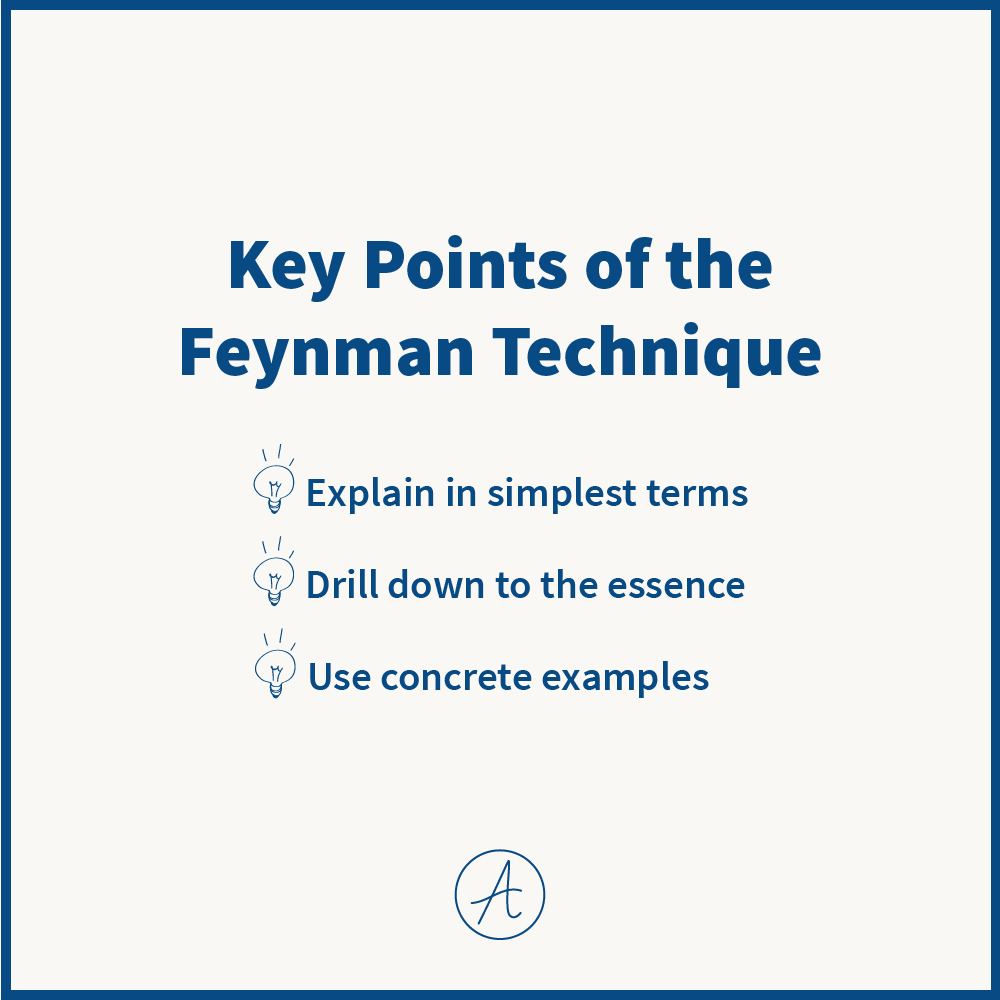
Active Recall⌗
Learning is not the process of putting info into the brain but taking info out of it. It physically changes the brain structure by creating new neural connections and strengthening the old ones. And Active Recall helps you do just that. It is just a fancy name for “testing yourself”.
Tests are not for judging your knowledge, but to strengthen it by practicing information retrieval. Your brain is like a muscle. The more you use it, the stronger it gets. By forcing you to think deeply about whatever you learn, a test solidifies your knowledge.
How can you test yourself without learning? Reading a piece of text is a passive action. It gives you a false sense of familiarity as you read it repeatedly. If you quiz yourself immediately after reading, it ensures understanding to a deeper level.
Suppose you read a chapter on “brain structure”, and you want to consolidate this knowledge. What should you do?
Simple. Close the book, ask yourself a question, and try answering it without any help. The clearer your answer is, the better is your understanding. And the prompts you use now will be useful later in the remembering stage, too.
Note-taking for Understanding?⌗
Note-taking is controversial. Study shows that summarizing content or taking notes with an open book is a very low utility task. Neither does it help understanding nor remembering.
However, it sure does help keep your brain awake during class. Taking notes forces you to pay attention. Coupled with the Cornell method3, note-taking during class can prove helpful in preparing active recall prompts, too.
Should you type out or hand-write your notes? To speak strictly based on evidence, handwriting is much better than digital notes. Unlike typing, pen-and-paper make you think, saving you from transcribing the entire lecture verbatim. This leads to better recall ability over long duration. But digital notes have some benefits, too.
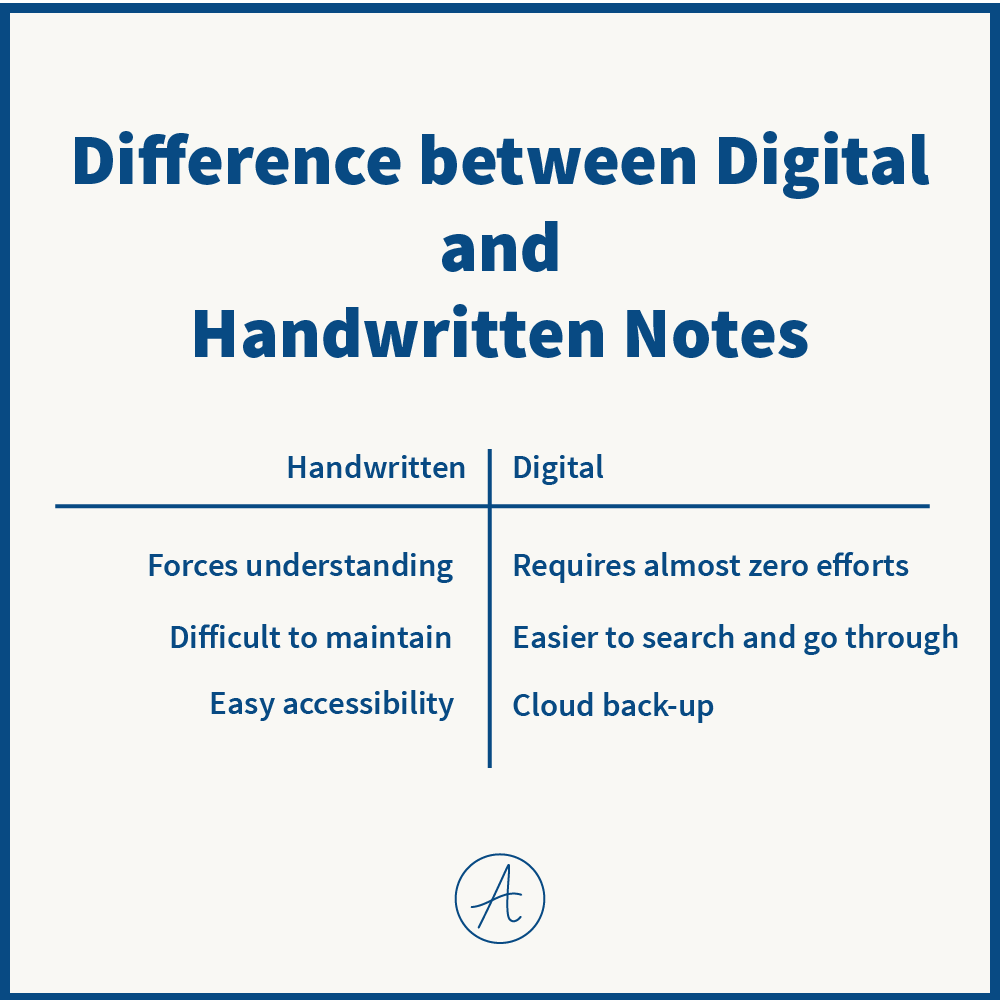
Interleaving⌗
As soon as you start getting the hang of it, switch. What does that mean?
Interleaving is shuffling of subjects or topics for improved learning. Evidence shows interleaving to be more effective than blocked practice for developing the skills such as categorization and problem solving along with better long-term retention and ability to transfer learnt knowledge. How to do that? Select several topics and spread them throughout your study session. The topics can be from any subject. However, interleaving requires a bit of calibration. Some experts believe that it helps more to have the selected topics related in some way.
So, when you start feeling mathematics easy, you probably should take a break from it. ;)
Connect the Dots and Use Concrete Examples⌗
If I ask you to explain how a nuclear plant functions, how would you start? With an analogy. Why?
Relating new concepts to the existing knowledge is the best way to understand and remember things. You can break down even the most complex things using this principle. You start revealing several interesting connections and concrete examples, once you start relating things together.
In place of a lung inflating in the vacuum of thoracic cavity, you would imagine a balloon in a bottle which is far more likely to stick in your brain.
Scoping the Subject⌗
Lay down the entire outline of the topic before you start learning. That is what scoping the subject means. Taking a bird’s eye view. Why to do so? Most of the times, we get so lost in the minute details of a chapter that we lose the sense of how it fits into the bigger picture. We end up losing our time on unimportant things rather than where it’s actually needed. An outline or a mind map, can help you avoid this.
2. Remembering⌗
Remembering is the core of learning, isn’t it? It is what makes all the difference in examinations. Let us see how to make it stick.
Spaced Repetition⌗
Spaced Repetition is revising concepts at increasing intervals. By preferring this over the “binge and purge method”, you can easily combat the forgetting curve hypothesized by Hermann Ebbinghaus and exploit the psychological spacing effect which demonstrates study sessions are more effective when spaced out. It also helps avoid the false sense of mastery that comes when you score excellent grades in tests that you take immediately after finishing a topic.
Forgetting curve is this phenomenon of exponential decay of memory when there is no attempt to preserve it. Which simply means that if you do not revise your chapter after learning it once, you are likely to forget all of it within a week.
If you complete “plant structure” today, you should revise it a day later, then maybe 4 days later, then a week, two weeks and so on. This technique does not have a rigid structure. You can alter the number of days as needed, but if you are not one of those focused maniacs, it can be a loss to you. To bring in some discipline/structure try using a retrospective revision timetable and the Leitner System.
Leitner System⌗
Leitner System is all about using flashcards efficiently. A flash card, in general, is a piece of paper with a question written on its one side and the answer on the other. You only get to see the answer after you attempt to answer first. It’s like someone quizzing you.
Where does the Leitner System fit in? It is kind of a marriage of active recall and spaced repetition. While revising flash cards, you must rank each card based on how difficult you find it at that point. If you are unable to answer the question or take long time for it, label it “difficult” and the one which you answer the quickest gets labelled “easy”. Then, as you proceed through the deck, the newly introduced and difficult cards are shown frequently while the old and easy ones less times.
Earlier you needed to use real boxes and papers. But now we have software that make it so easy and fun. I recommend using Anki or Quizlet for this.
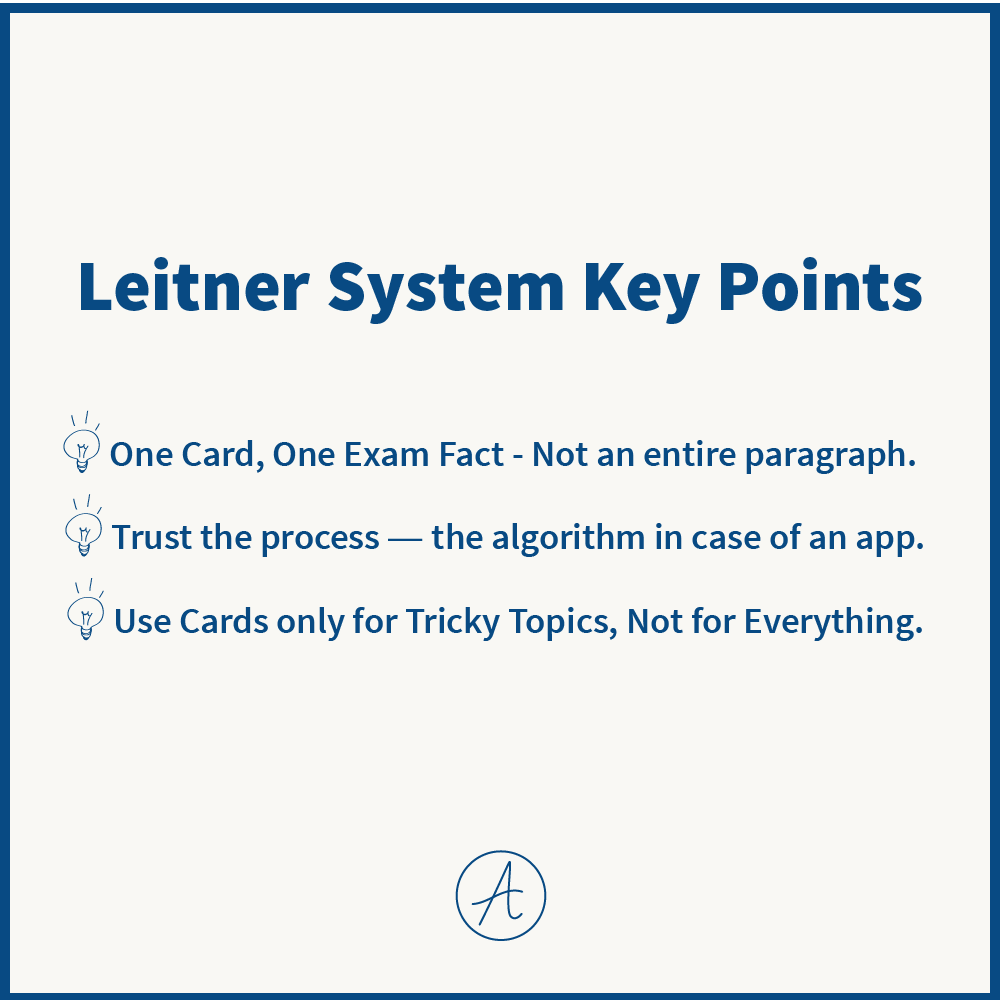
Dual-Coding⌗
The dual-coding theory postulates that both verbal and visual cues are used to represent the same information in our brain. At the same time, verbal and visual information is processed differently and along different channels in human mind. This gives you the ability to code a piece of information in two different ways. Thus, it also increases your chances and efficiency of retrieval.
Let us say that you interpret a stimulus concept “apple” as both, the word ‘apple’ and a picture of it. Later when you are asked to recall this stimulus, you can now either retrieve the word or the image individually or both at the same time, making it a bit easy to recall.
Retrospective Revision Timetable⌗
It is a term coined by Ali Abdaal who used this method himself.
Start with a blank sheet of paper or use the preferred spreadsheet app. Use as many columns and rows as you need. List down the concepts you are going to learn in the first column and leave out everything else blank.
As you start your revising the listed topics, mark the dates in the respective row of the subject and color-code the cell according to the level of difficulty you face recalling the information (e.g., green for easy, yellow for medium, and red for difficult). The next time you revise, you know which topic to choose first based on your own feedback.
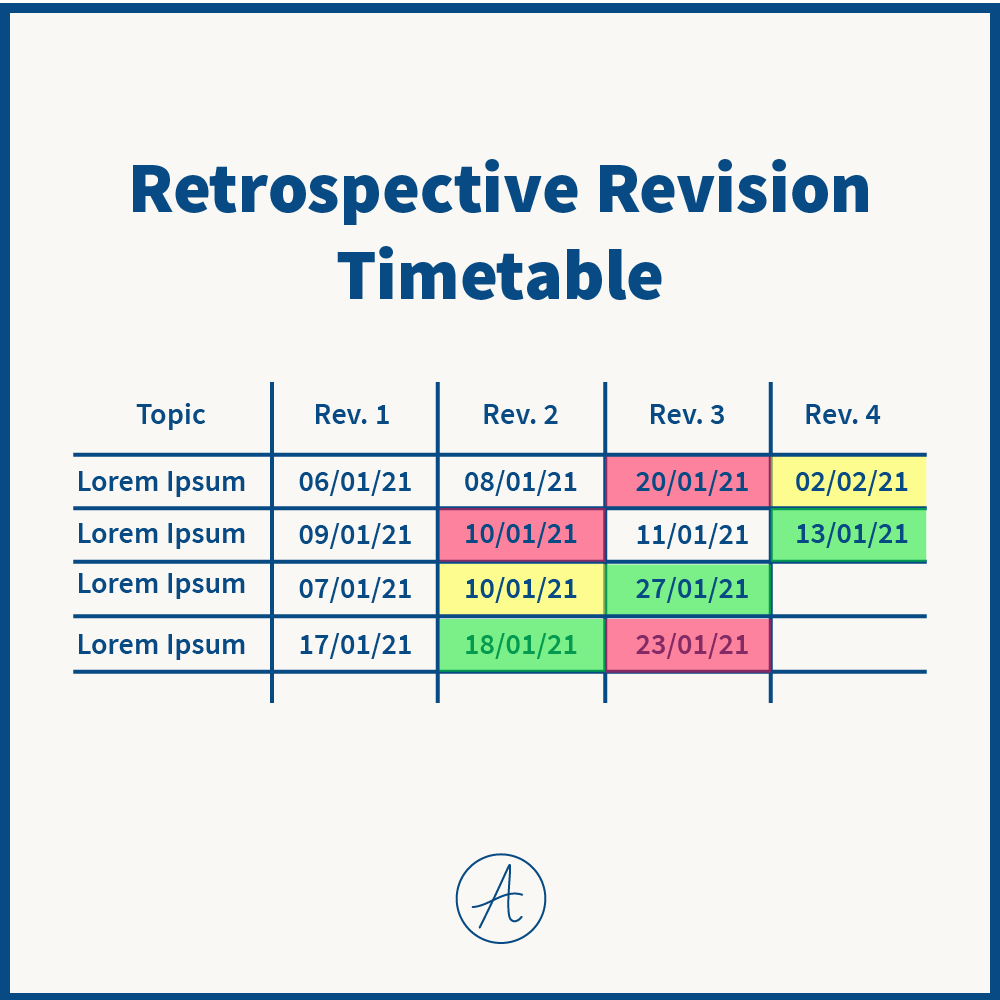
Mnemonics⌗
A mnemonic is a learning technique that makes remembering a list or a sequence super easy and super fun for you. Do you remember the “soh-cah-toa” from trigonometry? That might be one of the very first acronym-mnemonics you learnt.
A mnemonic can be anything. It can be a song, like we sing the ABCs, it can be an acronym like VIBGYOR which stands for the colors of rainbow or even a complete sentence. For example, “My Very Educated Mother Just Served Us Nachos” is a funny sentence to remember all the eight planetary names. Such mnemonics are especially useful for medical students where everything is centered around loads of information.
There is another system based on mnemonics called the Mnemonic Major System. It is used to remember numbers. People who deal with a lot of numbers might find it useful. In this system, every number relates to a consonant sound (e.g., ch, g). A string of numbers is then converted into a word by adding vowels. Try it out.

The Method of Loci / Mind Palace⌗
The mind palace was popularized by the Sherlock Holmes series in 2010. It is a sweet exercise for your brain which involves creating a mental picture of a place that we know extremely well and then connecting the thigs we need to remember with the things from this environment. Simple as that.
Suppose you need to quickly memorize a year – 1632. You could do that easily by imagining the ‘1’ as a walking stick in some old man’s hand near your house, the ‘6’ as your favorite shopkeeper’s face, ‘3’as your hair comb and the ‘2’ might be hanging on an electric pole. And you got it. You just remembered the year.
Mind Maps⌗
Mind Maps are a handy tool to organize your ideas, and for brainstorming. They help you visualize how things fit together and make it clear. I did not realize the power of mind maps until recently. In fact, to give an anecdotal example, this very essay was drafted first as a mind map. Take a look at it.
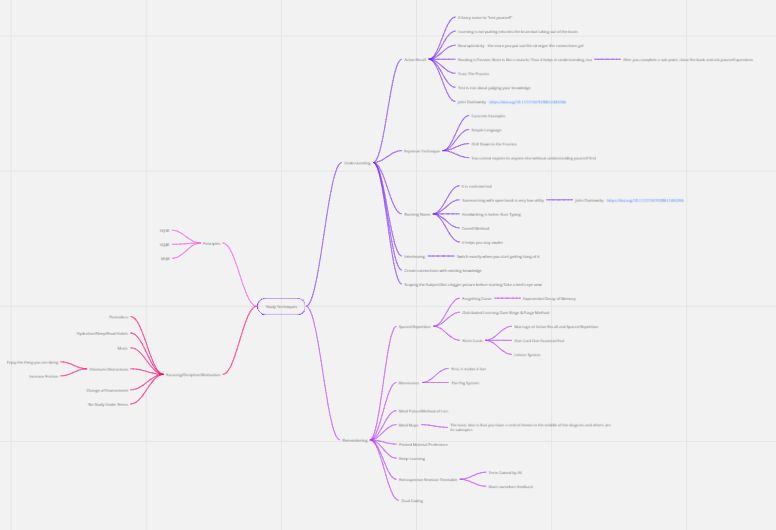
The Image is Quite Blur
The basic idea behind mind maps is to have a central topic in the middle of the diagram and branch out the ideas and concepts using lines and shapes. By the end, it looks like an octopus with its tentacles spread all over the place.
Sleep-Learning⌗
Your brain does not stop functioning even when you are asleep. On-going research shows that studying when you are tired helps your brain retain higher concentration of new skills.
The phenomena that if you fall asleep while thinking over some issue, you wake up having a solution, is the proof of it. That is just how our brain functions. Your sub-conscious mind continues working, strengthening the neural connections even when you are in your bed. So, review your study material before going to bed, and you might learn in sleep as well.
Prefer Printed Material⌗
While there is no solid evidence that printed books are better than digital ones, several studies suggest that the overall comprehension of the students using printed material was better than those using digital material. A psychology professor even found that students needed more repetition to learn new concepts if they were reading on a screen.
There is no harm in preferring print, right?
3. Focus and Motivation⌗
For most of us, this is the hardest part of learning. Understanding and remembering is fine. But how do you sit down and get it done in the first place?
Pomodoro Technique⌗
This a well-known time-management method used in several places. It simply asks you to do work in several short sprints (usually, 25 minutes) and take a 5-minute break after each one. Once you complete four consecutive sessions, take a long break of 15-minutes. The goal is to reduce the impact of external and internal interruptions in focus and flow. The technique works by deceiving your brain by into focusing for shorter durations.
Self-Care⌗
A study covered in the Research Digest found that lack of sleep impairs students’ ability to learn new information. And that even a 2% drop of water in body can cause memory impairment.
So, stay hydrated, maintain healthy eating habits, and sleep well. Avoid the urge of staying up late before exams, dump the junk food and always keep a water bottle close to you.
Change in Environment⌗
How many times have you been told to sit and study at one place? Now you can tell whoever says so to shut up. Haha.
Research has shown that studying in multiple places is more helpful than working in a single place (Smith et al, 1978) – if the context (environmental setting) of the learning does not vary, it becomes harder to remember the information elsewhere (e.g., in an exam hall).
Listening to Music⌗
For some people, music is the key tune out the rest of the world. It helps them focus and concentrate. Try and see if you are one of them.
But do not start blasting ‘heavy metal’ into your headphones while studying. Put on some calm and silent tracks most preferably without lyrics. If you don’t know what to play, I would recommend lo-fi hip-hop beats or even white noise.
Eliminate Distractions⌗
It is hard to fight distractions. Let us take your phone as an example. It is the worst distraction. Every notification distracts you. You get distracted by just even looking at it. What to do about such things?
Put them out of your sight. Simply by putting the phone out of your sight, you have made it harder for yourself to reach the phone. Simply by increasing the friction in doing what you do not want to do, you are making it harder for yourself to do it. The harder it is, the less likely you are to do it.
You also need to learn to enjoy what you are doing. Develop interest in the thing at hand. Distractions do not bother you when you are doing something you have interest in.
No Study Under Stress⌗
Stress hinders learning. UC Irvine researchers find that stress lasting as briefly as a couple of hours can engage corticotropin-releasing hormones that disrupt the process of creating and storing memories. So, there’s no use of studying a month before exams if you haven’t studied already.
Do not stress. Practice yoga or meditation daily. It keeps your mental health in good shape as well as increases your learning and retrieval efficiency.
Motivation is a Myth⌗
Yep, that is a title of a book. And it is absolutely true.
You do not need to “feel like doing it” to do it. Just do it. Just sit there and start learning. Turn over the first page, then second, third…and gradually you would enter the flow. Stop waiting for that special moment to begin learning. That might never come. Start implementing these evidence-based strategies and you would find studying a lot more fun.
What’s SQ3R, SQ4R and PQ4R?⌗
SQ3R, SQ4R and PQ4R are the guidelines based on the same principles discussed above. You can read on them separately if you want to.
The Next Problem — Implementation⌗
Albeit decades of research show that these techniques improve student performance drastically with very little extra effort, these are not used widely.
What students do out of the classroom is mostly unproductive. When left to their own devices, students mismanage time and easily default back to their bad habits. Wide implementation is not possible without making this part of the classroom curriculum.
Richard Feynman was an American physicist and was known as the greatest explainer. ↩︎